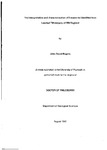The interpretation and characterisation of lineaments identified from Landsat TM imagery of SW England
| dc.contributor.author | Rogers, John David | |
| dc.contributor.other | School of Geography, Earth and Environmental Sciences | en_US |
| dc.date.accessioned | 2013-10-04T10:24:51Z | |
| dc.date.available | 2013-10-04T10:24:51Z | |
| dc.date.issued | 1997 | |
| dc.identifier | NOT AVAILABLE | en_US |
| dc.identifier.uri | http://hdl.handle.net/10026.1/2022 | |
| dc.description.abstract |
Two Landsat TM scenes of SW England and a sub-scene of North Cornwall have been analysed visually in order to examine the effect of resolution on lineament interpretation. Images were viewed at several different scales as a result of varying image resolution whilst maintaining a fixed screen pixel size. Lineament analysis at each scale utilised GIS techniques and involved several stages: initial lineament identification and digitisation; removal of lineaments related to anthropogenic features to produce cleansed lineament maps; compilation of lineament attributes using ARC/INFO; cluster analysis for identification of lineament directional families; and line sampling of lineament maps in order to determine spacing. SW England lies within the temperate zone of Europe and the extensive agricultural cover and infrastructure conceal the underlying geology. The consequences of this for lineament analysis were examined using sub-images of North Cornwall. Here anthropogenic features are visible at all resolutions between 30m and 120m pixel sizes but lie outside the observation threshold at 150m. Having confidence that lineaments at this resolution are of non-anthropogenic origin optimises lineament identification since the image may be viewed in greater detail. On this basis, lineament analysis of SW England was performed using image resolutions of 150m. Valuable geological information below the observation threshold in 150m resolution images is likely, however, to be contained in the lineament maps produced from higher resolution images. For images analysed at higher resolutions, therefore, knowledge-based rules were established in order to cleanse the lineament populations. Compiled lineament maps were 'ground truthed' (primarily involving comparison with published geological maps but included phases of field mapping) in order to characterise their geological affinities. The major lineament trends were correlated to lithotectonic boundaries, and cross-cutting fractures sets. Major lineament trends produced distinct frequency/orientation maxima. Multiple minor geological structures, however, produced semi-overlapping groups. A clustering technique was devised to resolve overlapping groups into lineament directional families. The newly defined lineament directional families were further analysed in two ways: (i) Analysis of the spatial density of the length and frequency of lineaments indicates that individual and multiple lineament directional families vary spatially and are compartmentalised into local tectonic domains, often bounded by major lineaments. Hence, such density maps provide useful additional information about the structural framework of SW England. (ii) Lineament spacing and length of the lineament directional families were analysed for the effect of scale and geological causes on their frequency/size distributions. Spacing of fracture lineaments were found to be power-law, whereas lengths showed power-law and non-power-law distributions. Furthermore the type of frequency/size distribution for a lineament directional family can change with increasing resolution. | en_US |
| dc.language.iso | en | en_US |
| dc.publisher | University of Plymouth | en_US |
| dc.title | The interpretation and characterisation of lineaments identified from Landsat TM imagery of SW England | en_US |
| dc.type | Thesis | |
| plymouth.version | Full version | en_US |
| dc.identifier.doi | http://dx.doi.org/10.24382/3888 | |
| dc.identifier.doi | http://dx.doi.org/10.24382/3888 |
Files in this item
This item appears in the following Collection(s)
-
01 Research Theses Main Collection
Research Theses Main


